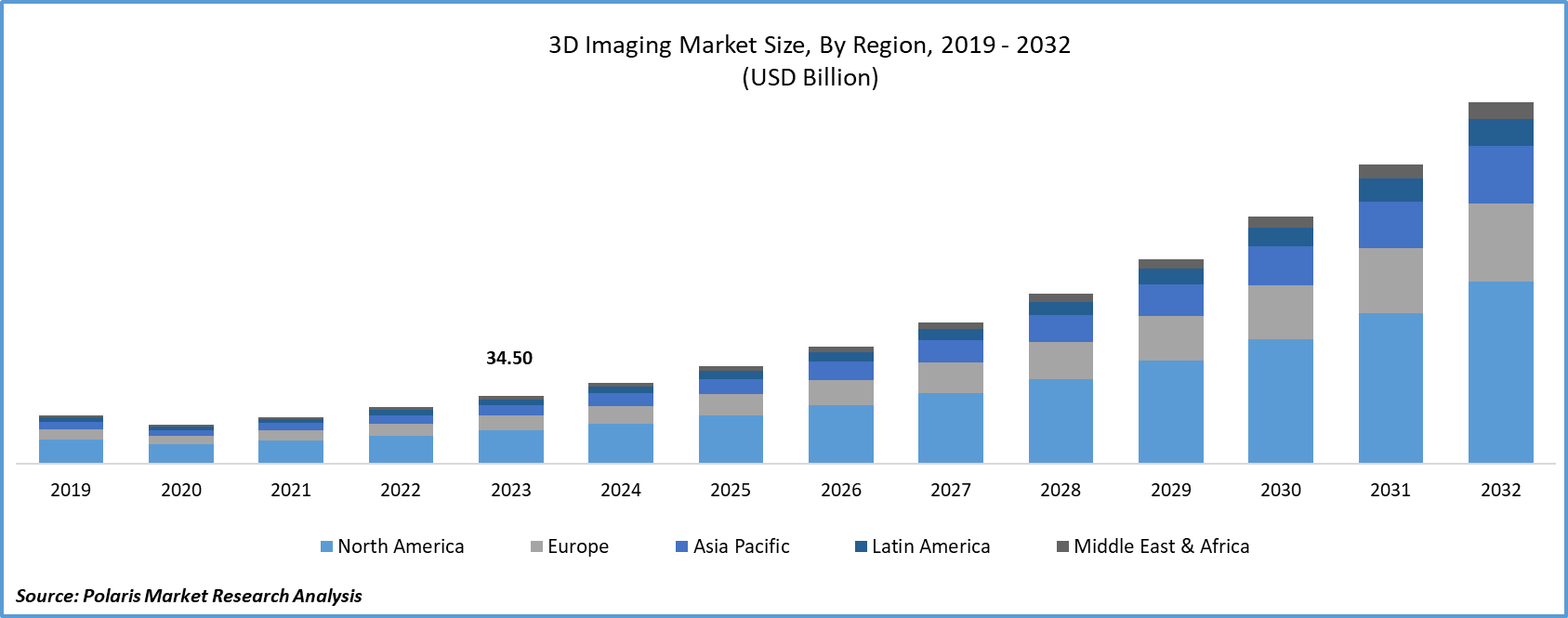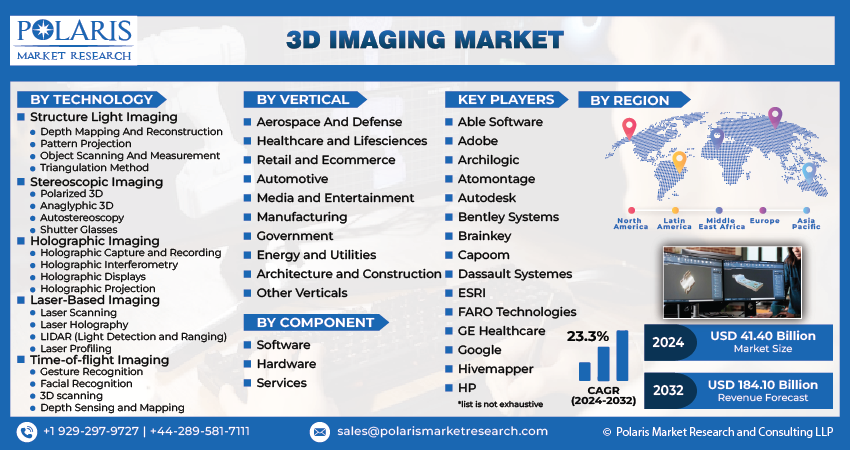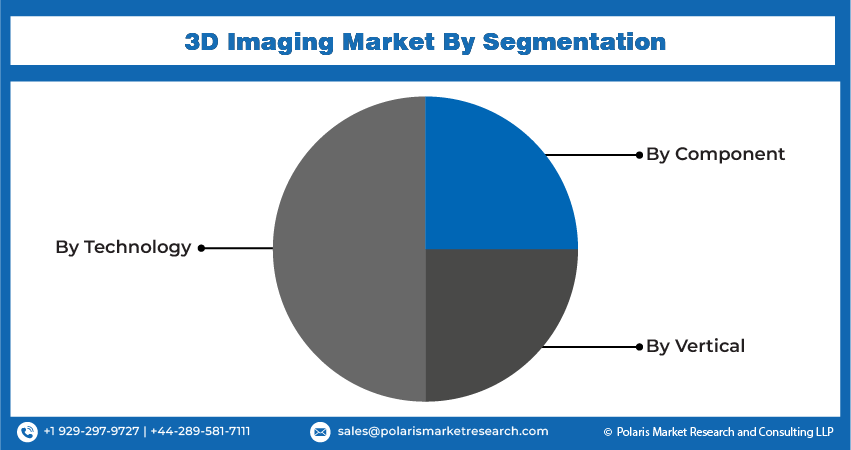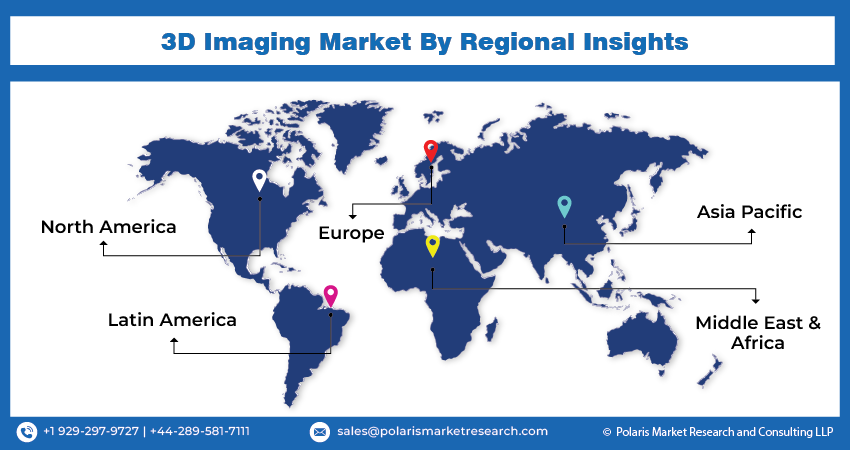
3D Imaging Market Share, Size, Trends, Industry Analysis Report, By Component (Hardware, Software, Services); By Technology; By Vertical; By Region; Segment Forecast, 2024 – 2032
- Published Date:Jan-2024
- Pages: 115
- Format: PDF
- Report ID: PM4273
- Base Year: 2023
- Historical Data: 2019 – 2022
Report Outlook
Global 3D imaging market size and share was valued at USD 34.50 billion in 2023. The market is anticipated to grow from USD 41.40 billion in 2024 to USD 184.10 billion by 2032, exhibiting the CAGR of 23.3% during the forecast period.
3D Imaging Market Overview
3D imaging involves generating a three-dimensional image to create the optical illusion of depth. This process typically utilizes two or more motion cameras to capture a three-dimensional object. The combination of 3D image sensors, cameras, and screens results in the creation of high-resolution images. Consequently, 3D imaging finds widespread applications in various industries, including hospitals, the entertainment sector, architecture and construction, and automotive.
Furthermore, the rising demand for 3D displays and sensors for high-resolution visualization, increasing awareness of 3D imaging, expanded usage in smartphones and tablets, and a surge in demand for industrial automation are driving the market.
Numerous industries in the 3D imaging sector favor this technology due to its high-resolution visualization capabilities. Additionally, the growing awareness among consumers has boosted the sales of consumer electronics, positively impacting the global market. However, ongoing research and development and the emergence of 4D technology are expected to further expand the consumer base in the future.
Moreover, the progressing advancements in the healthcare and life sciences sectors, coupled with the utilization of 3D technology for internal body structure visualization in treatment and diagnostics, are fueling the demand for 3D imaging technology in the medical field. Technical innovations are leading to a shift in consumer preferences toward high-resolution images, motion pictures, and animated films.

To Understand More About this Research: Request a Free Sample Report
Consequently, the media and entertainment industry are expected to drive the growth of the 3D imaging market. The phenomenal growth of the 3D imaging market is anticipated due to increased investments in artificial intelligence by the 3D medical imaging industry and growing demand from 3D retail and e-commerce during the forecasted period. The broader utilization of 3D imaging in the healthcare industry is foreseen as a response to the increasing demand for improved and more sophisticated healthcare facilities capable of delivering enhanced resolution and visualization for precise test diagnosis.
The report provides information on 3D imaging market revenue and sales at the global, national, and regional levels. Besides, it includes a detailed segmentation of the market, primarily based on types, applications, end-uses, and regions. Segmentation helps businesses and stakeholders plan their products, finances, and business strategies by considering the upcoming development rate for every segment.
3D imaging is concerned with the development of detailed 3D representations of objects. These objects are usually derived or reconstructed from a series of 2D images, data points, slices, or projections. There are several techniques for creating 3D images, including volume rendering, surface rendering, and multiplanar reconstruction (MPR). Volume rendering involves converting 2D data into 3D volume, whereas surface rendering is concerned with the extraction of required structures from 2D data. The MPR 3D imaging method involves reformatting 2D image data into different planes.
3D imaging is widely used in medicine to monitor, diagnose, and treat several conditions, especially in the fields of neurology, dentistry, oncology, cardiology, and gynecology. Along with medicine, it finds applications in other sectors, such as aerospace and defense, manufacturing, energy and utilities, and architecture and construction. There are several benefits associated with 3D imaging, including a more detailed representation of the object and the capability to inspect it completely. The growing utilization of 3D imaging in the media & entertainment, and gaming industries is the primary factor driving the 3D imaging market demand.
3D Imaging Market Dynamics
Market Drivers
- The increasing utilization of 3D imaging in the entertainment and media sector, contributing to market growth
The entertainment and media sector has experienced a significant upswing in the adoption of 3D imaging technologies, transforming the landscape of content creation, consumption, and experiences. Progress in 3D imaging has paved the way for immersive encounters in movies, gaming, virtual reality (VR), and augmented reality (AR), captivating audiences in novel ways. Within the film industry, 3D imaging has facilitated the development of visually striking special effects and realistic animations, enriching the overall cinematic experience. This technology has elevated storytelling and attracted audiences seeking more compelling and immersive entertainment.
Likewise, 3D imaging has revolutionized the gaming industry, providing a more lifelike and immersive gaming experience. The capability to depict intricate, three-dimensional environments and characters has reshaped the gaming landscape, resulting in more interactive and visually impressive gameplay. Furthermore, the incorporation of VR and AR technologies, fueled by 3D imaging, has introduced entirely new dimensions to storytelling and interactive experiences, offering users unprecedented levels of engagement.

For Specific Research Requirements, Request for a Customized Research Report
Market Restraints
- Field of View and Depth perception are likely to impede the market growth
The constraints related to the field of view and depth perception inherent in 3D imaging technologies can profoundly impact the thoroughness and precision of captured scenes or objects. Some 3D imaging systems may encounter challenges in capturing a complete field of view or accurately depicting depth information, particularly in complex or crowded environments. This limitation may give rise to incomplete or distorted representations, jeopardizing the fidelity of the generated 3D models. In crucial applications such as autonomous vehicles, robotics, or augmented reality, where precise spatial understanding is paramount, these constraints could impede the system's capacity to adeptly perceive and navigate environments, potentially resulting in errors or safety concerns.
Report Segmentation
The market is primarily segmented based on technology, component, vertical, and region.
|
By Technology |
By Component |
By Vertical |
By Region |
|
|
|
|
To Understand the Scope of this Report: Speak to Analyst
3D Imaging Market Segmental Analysis
By Component Analysis
- The Hardware segment held the largest revenue share in 2023. The increasing demand for 3D imaging devices, such as X-ray machines, ultrasound systems, CT, and MRI, in the healthcare sector, can be attributed to the rising need for accurate and detailed medical imaging. Additionally, the growing gaming and entertainment industry has boosted the demand for 3D imaging technology as viewers can experience a more immersive 3D experience with these technologies.
- The software industry is expected to grow rapidly over the forecast period with the fastest CAGR. This growth can be attributed to the increasing use of 3D imaging software in various industries such as healthcare, automotive, and manufacturing. Moreover, the popularity of this software is also growing in other sectors like architecture and construction, media and entertainment, and archaeological studies, which is driving the growth of this segment.
By Vertical Analysis
- The Healthcare and Lifesciences segment accounted for the highest market share during the forecast period. The rise can be linked to the expanding adoption and heightened requirement for 3D medical imaging technology in the healthcare sector for disease determination and diagnosis. The market has been categorized into automotive and transportation, healthcare and life science, architecture and construction, manufacturing, media and entertainment, and security and surveillance based on end-use. The surge is attributed to sedentary lifestyles, the escalating prevalence of chronic diseases globally, and a significant increase in the aging population, leading to a rise in lifestyle diseases and age-related illnesses. Consequently, there has been an upswing in demand for 3D imaging devices.
- The automotive and transportation segment is expected to demonstrate the highest CAGR during the forecast period. The segment's growth can be attributed to the advanced features provided by 3D imaging, a rise in the number of cars, increased utilization of advanced driver assistance systems (ADAS), and the increasing prevalence of driverless vehicles, all contributing to the automotive 3D imaging market. This technology facilitates applications in areas such as safety, parking surveillance, anti-theft measures, healthcare, social media, forensics, and mobile commerce.
3D Imaging Market Regional Insights
- North America region dominated the global market with the largest market share in 2023
The region is experiencing notable growth due to continuous developments undertaken by key players in countries like the U.S. and Canada. Leading players in the region are providing tailored solutions, including 3D animation, 3D modeling, 3D scanning, 3D layout, 3D rendering, and more, to end-users. For instance, in November 2020, Visage Imaging Inc. unveiled an enhanced edition of Visage 7 Live Connect, an enterprise imaging platform, enabling seamless real-time communication for end-users. This empowers radiologists to collaborate securely and share images.
The Asia Pacific region will experience the highest CAGR during the forecast period. The regional market's growth is primarily linked to the expansion of the healthcare, automation, media and entertainment, and manufacturing sectors. Asia Pacific nations like Japan, India, and China are witnessing increased investments due to the potential growth in these sectors. The rising technological awareness and adoption of 3D imaging in the region are also anticipated to drive market growth across the area throughout the forecast period.

Competitive Landscape
The 3D Imaging market is fragmented and is anticipated to witness competition due to several players' presence. Major service providers in the market are constantly upgrading their technologies to stay ahead of the competition and to ensure efficiency, integrity, and safety. These players focus on partnership, product upgrades, and collaboration to gain a competitive edge over their peers and capture a significant market share.

Some of the major players operating in the global market include:
- Able Software
- Adobe
- Archilogic
- Atomontage
- Autodesk
- Bentley Systems
- Brainkey
- Capoom
- Dassault Systemes
- ESRI
- FARO Technologies
- GE Healthcare
- Hivemapper
- HP
- Innersight
- Kaarta
- LightCode Photonics
- Lockheed Martin
- Maxon
- Panasonic
- Philips
- Pix4D
- Precismo
- Shapr3D
- Sony Corporation
- STMicroelectronics
- Topcon
- Trimble
- Vzense Technology
Recent Developments
- In November 2023, The University of Wisconsin and GE Healthcare declared a strategic collaboration for a 10-year period, extending their longstanding 40-year partnership. This fresh research collaboration broadens the current scope beyond medical imaging to explore new frontiers in digital technologies and solutions focused on diseases.
- In October 2023, Autodesk revealed its acquisition of Flexism, aiming to integrate factory simulation and operational efficiency analysis into its suite of factory design tools.
- In June 2023, Panasonic Factory Solutions Asia Pacific Pte. Ltd. (Panasonic), and the Singapore Centre for 3D Printing (SC3DP) developed an innovative multi-material printer utilizing multi-wavelength high-power lasers. This advancement enables the swift and uncomplicated 3D printing of intelligent, flexible devices.
Report Coverage
The 3D Imaging market report emphasizes key regions across the globe to provide a better understanding of the product to the users. Also, the report provides market insights into recent developments, and trends and analyzes the technologies that are gaining traction around the globe. Furthermore, the report covers an in-depth qualitative analysis pertaining to various paradigm shifts associated with the transformation of these solutions.
The report provides a detailed analysis of the market while focusing on various key aspects such as competitive analysis, technology, component, verticals, and futuristic growth opportunities.
3D Imaging Market Report Scope
|
Report Attributes |
Details |
|
Market size value in 2024 |
USD 41.40 billion |
|
Revenue Forecast in 2032 |
USD 184.10 billion |
|
CAGR |
23.3% from 2024 – 2032 |
|
Base year |
2023 |
|
Historical data |
2019 – 2022 |
|
Forecast period |
2024 – 2032 |
|
Quantitative units |
Revenue in USD billion and CAGR from 2024 to 2032 |
|
Segments Covered |
By Technology, By Component, By Vertical, By Region |
|
Regional scope |
North America, Europe, Asia Pacific, Latin America; Middle East & Africa |
|
Customization |
Report customization as per your requirements with respect to countries, regions, and segmentation. |
Navigate through the intricacies of the 2024 3D Imaging Market with precision, thanks to the comprehensive statistics on market share, size, and revenue growth rate assembled by Polaris Market Research Industry Reports. This thorough analysis not only provides a glimpse into the historical context but also extends its reach with a market forecast outlook until 2032. Immerse yourself in the richness of this industry analysis by securing a complimentary PDF download of the sample report.
FAQ's
key companies in 3D Imaging Market are Adobe, Archilogic, Atomontage, Autodesk, Bentley Systems, Brainkey, Capoom, Dassault Systemes
3D Imaging Market exhibiting the CAGR of 23.3% during the forecast period
The 3D Imaging Market report covering key segments are technology, component, vertical, and region.
key driving factors in 3D Imaging Market 1. The increasing utilization of 3D imaging in the entertainment and media sector, contributing to market growth.
The global 3D Imaging market size is expected to reach USD 184.10 billion by 2032
